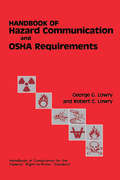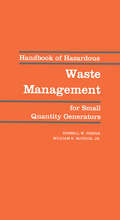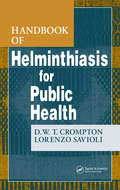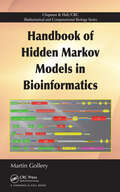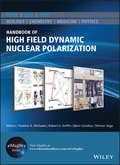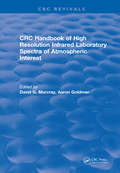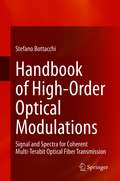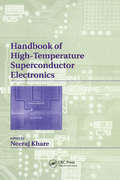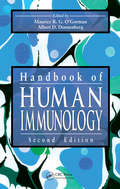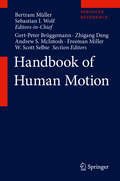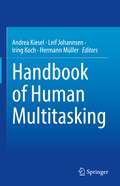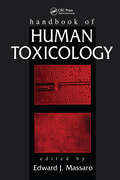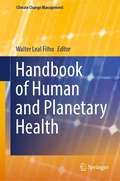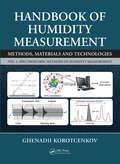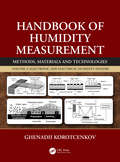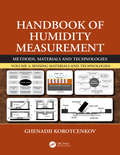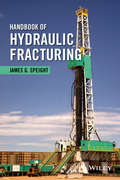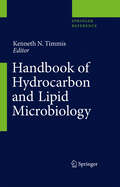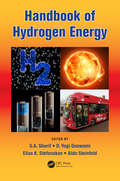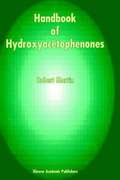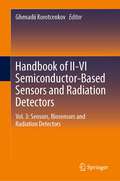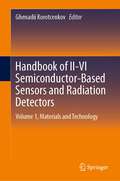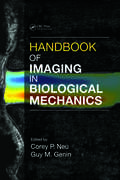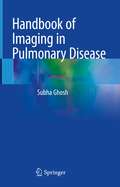- Table View
- List View
Handbook of Hazard Communication and OSHA Requirements
by George G. LowrySome 70,000 hazardous materials are in various workplaces across the country...regulated by the OSHA Hazard Communication Standard not only for chemical manufacturers and distributors, but soon, for all other U.S. manufacturers—and many others as well. This guide provides a step-by-step understanding of the standard. With this book you should be able to plan, organize and operate your company's Hazard Communication Program...to protect your employees (and your company) as required by OSHA. This handbook is especially intended for use by industrial hygienists, safety directors, safety engineers, occupational health departments, managers, environmental engineers, legal staff, and consultants. Hazard Communication and OSHA Requirements explains carefully in non-legalistic terms just what will be required, and when. But even more important, it explains in detail, with examples where appropriate.
Handbook of Hazardous Waste Management for Small Quantity Generators
by Russell W. PhiferSpecial features of this book include: practical "how to" instructions, state/federal regulations-plus overview, lab waste management, interpretations of regulations, enforcement, generator checklist, and complete coverage. This handbook is an excellent resource for hazardous waste managers, safety managers, lab managers, occupational health/safety workers, hazardous waste brokers, and small business managers. Disposal facilities, trade associations, consultants, administrators, attorneys, unions, and industrial hygienists will find this practical guide useful as well.
Handbook of Helminthiasis for Public Health
by D. W. Crompton Lorenzo SavioliWritten by internationally respected experts, Handbook of Human Helminthiasis provides information essential in the development of an integrated approach to the prevention, control and treatment of disease caused by endoparasitic helminths. The text is divided into sections dealing with the main groups of helminth infections and the diseases they i
Handbook of Hidden Markov Models in Bioinformatics
by Martin GolleryDemonstrating that many useful resources, such as databases, can benefit most bioinformatics projects, the Handbook of Hidden Markov Models in Bioinformatics focuses on how to choose and use various methods and programs available for hidden Markov models (HMMs).The book begins with discussions on key HMM and related profile methods, incl
Handbook of High Field Dynamic Nuclear Polarization (eMagRes Books)
by PolarizationAddresses Dynamic Nuclear Polarization (DNP) as a technique for sensitivity-enhancement in solid-state NMR spectroscopy This comprehensive handbook is a compendium of the current state-of-the art of high field Dynamic Nuclear Polarization—from long-proven, early developments, up to today’s hot topics. It covers all the relevant subjects that have made a direct or indirect contribution toward advancing this field, and focuses on topics such as: the theory behind the effects seen within DNP; instrumentation required for carrying out DNP; and specific applications of DNP including protein monitoring, catalysis, nanoparticles, biological and clinical studies. Development and application of techniques that have indirectly contributed to advancing MAS DNP NMR, such as DNP experiments on static solids within microwave resonant structures, and high-field EPR, are also examined. Handbook of High Field Dynamic Nuclear Polarization is presented in three sections—Theoretical Aspects, DNP Development (instrumentation / radical / sample), and DNP NMR Applications. The first section offers chapters on; solid and cross effect DNP; thermal mixing; Overhauser; and dissolution DNP. The second looks at: microwave technology, gyrotron, and IOE; homebuilt and commercial DNP spectrometers; and glassing vs. solvent-free DNP. The final section provides information on; amyloid, membrane, and nanocrystalline proteins; metals, and surface enhanced DNP; pharmaceuticals; nanoparticles; and much more. Covers one of the biggest developing fields in magnetic resonance Relevant to students, academics, and industry within the physical, materials, medical, and biochemical sciences An excellent starting point and point-of-reference for researchers in the field Edited by a widely respected team with contributions from key researchers in the NMR community Part of the eMagRes Handbook Series Handbook of High Field Dynamic Nuclear Polarization is an ideal reference for all researchers and graduate students involved in this complex, interdisciplinary field. About eMagRes Handbooks eMagRes publishes a wide range of online articles on all aspects of magnetic resonance in physics, chemistry, biology and medicine. The existence of this large number of articles, written by experts in various fields, is enabling the publication of a series of eMagRes Handbooks on specific areas of NMR and MRI. The chapters of each of these handbooks will comprise a carefully chosen selection of eMagRes articles. In consultation with the eMagRes Editorial Board, the eMagRes Handbooks are coherently planned in advance by specially-selected Editors, and new articles are written to give appropriate complete coverage. The handbooks are intended to be of value and interest to research students, postdoctoral fellows and other researchers learning about the scientific area in question and undertaking relevant experiments, whether in academia or industry. Have the content of this Handbook and the complete content of eMagRes at your fingertips! Visit: www.wileyonlinelibrary.com/ref/eMagRes
Handbook of High Resolution Infrared Laboratory Spectra of Atmospheric Interest (CRC Press Revivals)
by Aaron Goldman David G. MurcrayThe handbook presents spectra to be utilized for the detection and measurement of new constituents in the earth's atmosphere and to obtain data for common minor species with large gas amounts in the absorption cell (such as CH/sub 4/ and N/sub 2/O). These results can be applied in the identification of absorption features in atmospheric spectra determined over long atmospheric paths. The spectra were recorded with Fourier Transform Spectrometers which are more precise than grating spectrometers. Each molecule spectrum was plotted on two scales: a condensed scale covering the range from 75 to 300/cm in one frame, and an expanded view covering 20 or 10/cm per frame. Each plot contains the name of the molecule, chemical formula, the gas pressure, cell length, and estimated resolution of the spectrum.
Handbook of High-Order Optical Modulations: Signal and Spectra for Coherent Multi-Terabit Optical Fiber Transmission
by Stefano BottacchiThis book highlights many fundamental aspects of optical fiber transmission engineering while also focusing on current state of the art applications and working examples of digital coherent optical communications. Major engineering themes are reviewed and analyzed in this book, including spectral and time-domain characteristics of multi-level pseudo-random PAM signals, optical QAM and SSB complex modulations and impulse response engineering of linear amplifiers used in next-generation Gbaud transmission systems. This book is balanced between theoretical and numerical simulation approaches, showing numerous working examples developed in Matlab. Presents an in-depth analysis of pseudo-random multi-level signals and high-order complex modulations to support coherent terabit transmission systems;Provides a unified approach to challenging engineering issues encountered in the design of Giga-baud coherent optical transmission systems using high-order complex modulation formats;Reviews engineering themes and provides in-depth analysis, modeling and quantitative examples and solutions of state of the art and future applications.
Handbook of High-Temperature Superconductor (Applied Physics Ser. #Vol. 7)
by Neeraj KhareDevoted to the preparation, characterization and evaluation of HTS electronic devices, the Handbook of High-Temperature Superconductor Electronics provides information on using high-Tc thin films and junctions to increase speed, lessen noise, lower power consumption and enhance upper frequency limits in superconductor electronics. Compiled by a gro
Handbook of Human Immunology
by Maurice R. G. O’GormanSince the publication of the first edition of the Handbook of Human Immunology in 1997, major scientific achievements have directly contributed to an increased understanding of the complexities of the human immune system in health and disease. Whether as a result of the sequencing of the entire human genome, or of technological advancements, severa
Handbook of Human Motion
by Bertram Müller Sebastian I. Wolf Gert-Peter Brüggemann Zhigang Deng Andrew S. McIntosh Freeman Miller W. Scott SelbieThe Handbook of Human Motion is a large cross-disciplinary reference work which covers the many interlinked facets of the science and technology of human motion and its measurement. Individual chapters cover fundamental principles and technological developments, the state-of-the-art and consider applications across four broad and interconnected fields; medicine, sport, forensics and animation. The huge strides in technological advancement made over the past century make it possible to measure motion with unprecedented precision, but also lead to new challenges. This work introduces the many different approaches and systems used in motion capture, including IR and ultrasound, mechanical systems and video, plus some emerging techniques. The large variety of techniques used for the study of motion science in medicine can make analysis a complicated process, but extremely effective for the treatment of the patient when well utilised. The handbook describes how motion capture techniques are applied in medicine, and shows how the resulting analysis can help in diagnosis and treatment. A closely related field, sports science involves a combination of in-depth medical knowledge and detailed understanding of performance and training techniques, and motion capture can play an extremely important role in linking these disciplines. The handbook considers which technologies are most appropriate in specific circumstances, how they are applied and how this can help prevent injury and improve sporting performance. The application of motion capture in forensic science and security is reviewed, with chapters dedicated to specific areas including employment law, injury analysis, criminal activity and motion/facial recognition. And in the final area of application, the book describes how novel motion capture techniques have been designed specifically to aid the creation of increasingly realistic animation within films and video games, with Lord of the Rings and Avatar just two examples. Chapters will provide an overview of the bespoke motion capture techniques developed for animation, how these have influenced advances in film and game design, and the links to behavioural studies, both in humans and in robotics. Comprising a cross-referenced compendium of different techniques and applications across a broad field, the Handbook of Human Motion provides the reader with a detailed reference and simultaneously a source of inspiration for future work. The book will be of use to students, researchers, engineers and others working in any field relevant to human motion capture.
Handbook of Human Multitasking
by Hermann Müller Andrea Kiesel Iring Koch Leif JohannsenThis handbook on human multitasking provides an integrative overview on simultaneous and sequential multitasking and thus combines theorizing on dual task limitations as well as costs related to task switching. In addition to a wide range of empirical findings and their theoretical integration, the editors provide a number of applications of multitasking, like training, interindividual differences and applied research in traffic and health psychology and music expertise.The book is suitable for people interested in multitasking, that is, for researchers and graduate students of cognitive psychology, movement science, sport psychology, cognitive neuroscience, cognitive and neurological rehabilitation, aging sciences, and broader cognitive science.
Handbook of Human Oocyte Cryopreservation
by Eleonora Porcu MD Patrizia Maria Ciotti Stefano Venturoli Patrizia Maria CiottiHuman oocyte cryopreservation has undergone rapid growth, with technical improvement and increasing clinical application over the last ten years. Storing eggs is ethical and gives many young women their most realistic chance of conception. Cryopreservation, however, is still considered by many as an experimental technique and conflicting reports are published as to its efficacy. For these reasons, it is necessary to give reproductive researchers and practitioners comprehensive and systematic information about the field. This book describes and analyses the history of human oocyte freezing, the main steps of technical evolution, and the pros and cons of different techniques. In addition, the clinical applications, long-term outcome, efficiency and safety of oocyte cryopreservation are detailed. The Handbook of Human Oocyte Cryopreservation gives a complete picture of the field today and is a valuable text for embryologists, cryobiologists, reproductive medicine practitioners and anyone involved in researching and implementing the technique.
Handbook of Human Toxicology
by Edward J. MassaroCovering some of the most important topics in modern toxicology, the Handbook of Human Toxicology is a unique and valuable addition to the current literature. It addresses issues, answers questions, and provides data related to. Within each of these five major sections are several carefully selected topics that reflect the current state of human to
Handbook of Human and Planetary Health (Climate Change Management)
by Walter Leal FilhoThis book contains a set of papers which explore the subject matter of human and planetary health at various angles The year 2015 was a special year in the field of human and planetary health. In that year, the report, produced by the Rockefeller Foundation and the journal The Lancet, called “Safeguarding human health in the Anthropocene epoch: report of The Rockefeller Foundation-Lancet Commission on planetary health” was launched. Also in 2015, the World Health Organization and the Secretariat of the Convention on Biological Diversity published the report “Connecting global priorities: biodiversity and human health: a state of knowledge review” with over 100 contributors, meant to guide future joint actions. Both documents comprehensively address the need for a better understanding of the connections between human health and ecosystems and the risks associated with damages to the integrity of the planet. The period in which humanity finds itself right now, the Anthropocene, is a risk one since mankind is putting the planet under considerable pressure. These elements have led to the emergence of a new field of research, namely planetary health. Planetary health seeks to address a very concrete and urgent contemporary problem, namely the need to understand, quantify, and act in order to reverse the effects of human population growth and the acceleration of socioeconomic activities on the environment and, inter alia, the disturbances in the Earth's natural ecosystems and how these, in turn, impact human health and well-being. Anthropic disturbances in natural ecosystems are characterized by changes in climate, land use, changes in the nitrogen and phosphorus cycle, chemical pollution of soil, water and air, reduction in the availability of drinking water, loss of biodiversity, destruction of the ozone layer, and ocean acidification, among others. In all these areas, there is a perceived need to document and promote examples of initiatives and good practice, which may change current trends. This book addresses this need. It documents experiences, case studies, and projects which explore the connections between human and planetary health and illustrates examples which show the consequences of ecosystemic disturbances to the health and well-being of humanity, with the emergence of new diseases, worsening of infectious diseases and increase in chronic non-communicable diseases related to the deterioration of the current food system, hyper-urbanization, microbial resistance, climate-led migration and zoonoses, among others. Planetary health is a new effort to deal with the question of sustainability and human life on the planet under an increasingly integrative, transdisciplinary, and global perspective, since the problems of this planetary crisis cross geopolitical borders and academic boundaries and affect humanity as a whole. This book provides a contribution to this emerging field. Thanks to its design and the contributions by experts from various areas, it provides a welcome contribution to the literature on planetary health, and it inspires further works in this field.
Handbook of Humidity Measurement, Volume 1: Spectroscopic Methods of Humidity Measurement
by Ghenadii KorotcenkovThe first volume of The Handbook of Humidity Measurement focuses on the review of devices based on optical principles of measurement such as optical UV, fluorescence hygrometers, optical and fiber-optic sensors of various types. Numerous methods for monitoring the atmosphere have been developed in recent years, based on measuring the absorption of electromagnetic field in different spectral ranges. These methods, covering the optical (FTIR and Lidar techniques), as well as a microwave and THz ranges are discussed in detail in this volume. The role of humidity-sensitive materials in optical and fiber-optic sensors is also detailed. This volume describes the reasons for controlling the humidity, features of water and water vapors, and units used for humidity measurement.
Handbook of Humidity Measurement, Volume 2: Electronic and Electrical Humidity Sensors
by Ghenadii KorotcenkovBecause of unique water properties, humidity affects many living organisms, including humans and materials. Humidity control is important in various fields, from production management to creating a comfortable living environment. The second volume of The Handbook of Humidity Measurement is entirely devoted to the consideration of different types of solid-state devices developed for humidity measurement. This volume discusses the advantages and disadvantages about the capacitive, resistive, gravimetric, hygrometric, field ionization, microwave, Schottky barrier, Kelvin probe, field-effect transistor, solid-state electrochemical, and thermal conductivity-based humidity sensors. Additional features include: Provides a comprehensive analysis of the properties of humidity-sensitive materials, used for the development of such devices. Describes numerous strategies for the fabrication and characterization of humidity sensitive materials and sensing structures used in sensor applications. Explores new approaches proposed for the development of humidity sensors. Considers conventional devices such as phsychometers, gravimetric, mechanical (hair), electrolytic, child mirror hygrometers, etc., which were used for the measurement of humidity for several centuries. Handbook of Humidity Measurement, Volume 2: Electronic and Electrical Humidity Sensors provides valuable information for practicing engineers, measurement experts, laboratory technicians, project managers in industries and national laboratories, as well as university students and professors interested in solutions to humidity measurement tasks as well as in understanding fundamentals of any gas sensor operation and development.
Handbook of Humidity Measurement, Volume 3: Sensing Materials and Technologies
by Ghenadii KorotcenkovBecause of unique water properties, humidity affects materials and many living organisms, including humans. Humidity control is important in various fields, from production management to creating a comfortable living environment. The range of materials that can be used in the development of humidity sensors is very broad, and the third volume of the Handbook of Humidity Measurement offers an analysis on various humidity-sensitive materials and sensor technologies used in the fabrication of humidity sensors and methods acceptable for their testing. Additional features include: numerous strategies for the fabrication and characterization of humidity-sensitive materials and sensing structures used in sensor applications, methods and properties to develop smaller, cheaper, more robust, and accurate devices with better sensitivity and stability, a guide to sensor selection and an overview of the humidity sensor market, and new technology solutions for integration, miniaturization, and specificity of the humidity sensor calibration. Handbook of Humidity Measurement, Volume 3: Sensing Materials and Technologies provides valuable information for practicing engineers, measurement experts, laboratory technicians, project managers in industries and national laboratories, and university students and professors interested in solutions to humidity measurement tasks. Despite the fact that this book is devoted to the humidity sensors, it can be used as a basis for understanding fundamentals of any gas sensor operation and development.
Handbook of Hydraulic Fracturing
by James G. SpeightPresents an up-to-date description of current and new hydraulic fracturing processes Details Emerging Technologies such as Fracture Treatment Design, Open Hole Fracturing, Screenless Completions, Sand Control, Fracturing Completions and Productivity Covers Environmental Impact issues including Geological Disturbance; Chemicals used in Fracturing; General Chemicals; Toxic Chemicals; and Air, Water, Land, and Health impacts Provides many process diagrams as well as tables of feedstocks and their respective products
Handbook of Hydrocarbon and Lipid Microbiology
by Jan Roelof Meer Kenneth N. Timmis Terry Mcgenity Victor De LorenzoThis handbook provides a comprehensive overview of microbial interactions with the major forms of hydrocarbons, oils, and lipids in or entering the biosphere. It is the definitive resource on the physiological mechanisms and adaptive strategies characteristic of the microbial lifestyle that plays out at hydrophobic material: aqueous liquid interfaces.
Handbook of Hydrogen Energy (Mechanical and Aerospace Engineering Series)
by D. Yogi Goswami S. A. Sherif Aldo Steinfeld Elias K. StefanakosCan hydrogen and electricity supply all of the world's energy needs? Handbook of Hydrogen Energy thoroughly explores the notion of a hydrogen economy and addresses this question. The handbook considers hydrogen and electricity as a permanent energy system and provides factual information based on science. The text focuses on a large cross section o
Handbook of Hydroxyacetophenones
by Robert MartinThird Edition entitled Aromatic Hydroxyketones: Preparation and Physical Properties to be published in 2010 as a 4-volume handbook set including: Vol. 1: Hydroxybenzophenones Vol. 2: Hydroxyacetophenones I Vol. 3: Hydroxyacetophenones II Vol. 4: Hydroxypropiophenones, Hydroxyisobutyrophenones, Hydroxypivalophenones and Derivatives --------------- Hydroxyacetophenones constitute the starting material for a wide variety of syntheses in organic chemistry. They are versatile building blocks serving many different applications, such as specialty polymers, pharmaceuticals and fine chemicals. In this Handbook the diverse ways of obtaining over 3000 hydroxyacetophenones are described and their physico-chemical properties and spectroscopic data references are indicated. The Handbook is presented in dictionary style, with a logical classification of the ketones, making the information easily available for consultation. Ketones are classified methodically. They are thus easily accessible from three tables: - the molecular formula index - the chemical abstracts registry - the usual names index. This completely revised and enlarged edition includes: - 10 additional chapters compared with the previous edition which had just 2 chapters - an additional 1500 ketones - updated information for ~1200 ketone entries - the addition of di- and polyketones - approximately 3500 references. This Handbook is the reference on hydroxyacetophenones. It is a powerful synthesis tool for the researcher or industrial producers. Nowhere else are so many compounds covered or the physical properties and relevant syntheses provided. It provides a wide choice of hydroxyketones required to achieve syntheses based upon this range of intermediates.
Handbook of II-VI Semiconductor-Based Sensors and Radiation Detectors: Vol. 3: Sensors, Biosensors and Radiation Detectors
by Ghenadii KorotcenkovThe reference provides interdisciplinary discussion for diverse II-VI semiconductors with a wide range of topics. The third volume of a three volume set, the book provides an up-to-date account of the present status of multifunctional II-VI semiconductors, from fundamental science and processing to their applications as various sensors, biosensors, and radiation detectors, and based on them to formulate new goals for the further research. The chapters in this volume provide a comprehensive overview of the manufacture, parameters and principles of operation of these devices. The application of these devices in various fields such medicine, agriculture, food quality control, environment monitoring and others is also considered. The analysis carried out shows the great potential of II-VI semiconductor-based sensors and detectors for these applications.Considers solid-state radiation detectors based on semiconductors of II-VI group and their applications;Analyzes the advantages of II-VI compounds to develop chemical and optical gas and ion sensors; Describes all types of biosensors based on II-VI semiconductors and gives examples of their use in various fields.
Handbook of II-VI Semiconductor-Based Sensors and Radiation Detectors: Volume 1, Materials and Technology
by Ghenadii KorotcenkovThree-volumes book “Handbook of II-VI Semiconductor-Based Sensors and Radiation Detectors” is the first to cover both chemical sensors and biosensors and all types of photodetectors and radiation detectors based on II-VI semiconductors. It contains a comprehensive and detailed analysis of all aspects of the application of II-VI semiconductors in these devices. The first volume "Materials and Technologies" of a three-volume set describes the physical, chemical and electronic properties of II-VI compounds, which give rise to an increased interest in these semiconductors. Technologies that are used in the development of various devices based on II-VI connections, such as material synthesis, deposition, characterization, processing, and device fabrication, are also discussed in detail in this volume. It covers also topics related to synthesis and application of II-VI-based nanoparticles and quantum dots, as well their toxicity, biocompatibility and biofunctionalization.
Handbook of Imaging in Biological Mechanics
by Guy M. Genin Corey P. NeuEmerging imaging techniques have opened new fronts to investigate tissues, cells, and proteins. Transformative technologies such as microCT scans, super-resolution microscopy, fluorescence-based tools, and other methods now allow us to study the mechanics of cancer, dissect the origins of cellular force regulation, and examine biological specimens
Handbook of Imaging in Pulmonary Disease
by Subha GhoshThis book is a comprehensive and easy-to-read guide to pulmonary imaging. Medical Imaging is one of the cornerstones of modern medicine, and nowhere is this more apparent than pulmonary disease. We have come a long way from the days of chest radiography, though the chest radiograph still remains the single most common imaging test ordered worldwide. Pulmonary disease is now routinely evaluated with ultra-modern computed tomography (CT), magnetic resonance imaging (MRI) and positron emission tomography (PET) scanners, while ultrasonography plays a limited role in critical care and pleural/chest wall diseases. Rapid advancements in the sub-specialty of chest imaging and an exponential increase in the knowledge of pulmonary disease have led to an increasing demand for a comprehensive yet easily digestible handbook of pulmonary imaging, which prepackages knowledge in a form that can be easily understood and readily visualized with high-quality representative images.This book answers that need by providing the most important, relevant medical knowledge needed to handle pulmonary cases. It is divided into two sections, neoplastic disease and non-neoplastic disease. Chapters detail essential information about each disease, including presentation and the different modalities used to accurately diagnose and/or plan treatment. Major topics that are covered include bronchogenic carcinoma and other lung tumors, COPD, ILD, developmental lung disorders, pulmonary hypertension, and pulmonary infections. Each chapter includes extensive radiographic images to give a complete perspective on how these diseases present. Readers can easily see what the radiology of a particular disease entity looks like, what would be the differential diagnoses for a particular imaging abnormality, and compare the bullet review points associated with an image to their particular case.This is an ideal guide for general and thoracic radiologists, pulmonary, sleep medicine, and critical care specialists, thoracic surgeons, as well as residents and all clinicians who treat patients with pulmonary disease.
